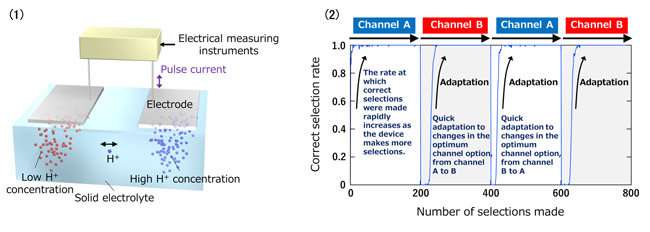Figure 1. Schematic diagram of an ionic device capable of learning and decision-making using electrochemical phenomena induced by the movement of hydrogen ions. Figure 2. The ionic device learns the current usage of communication channels A and B and quickly determines which should be assigned for a given transmission in order to achieve the most effective utilization of these channels. The diagram indicates optimum selections between channel A and B in relation to time. Credit: National Institute for Materials Science
A NIMS research group has invented an ionic device, termed an ionic decision-maker, capable of quickly making its own decisions based on previous experience using changes in ionic/molecular concentrations. The group then succeeded in demonstrating its operation. This device is capable of making decisions while efficiently adapting to changing situations by a means unrelated to the storage of past experiences in computer memory or to the performance of decision-making computations. This invention may lead to the development of novel artificial intelligence (AI) systems able to process analog information using hardware in a completely different manner from conventional AI systems that process digital information using software.
AI systems capable of quickly making optimum selections in response to changing circumstances in various fields—such as information and communications, manufacturing, economic activities and entertainment—are urgently needed. Efforts in recent years have focused on the development of computer-based AI systems capable of processing large amounts of information using sophisticated programs. However, these systems have some issues: when they are used to solve complex problems using vast amounts of data, their operations slow down and consume large amounts of electricity.
This research group developed a decision-making ionic device capable of operating using electrochemical phenomena induced by the movement of protons (H+) within a solid electrolyte. When the device makes a correct decision, ions migrate toward the electrode associated with the decision. Repeated correct decisions cause a variation in ionic/molecular concentrations and reinforce the decision. The research group applied this mechanism to a congested radio communication network and succeeded in demonstrating that the device is capable of selecting an optimum communication channel (i.e., frequency range) to be assigned for a given transmission in order to achieve the most effective overall channel utilization in relation to changing congestion situations. The device also demonstrated the capability to make optimum channel selections to meet an even more complex goal, i.e., achieving the most effective overall channel utilization among multiple communication network users.
In future studies, we hope to develop this technology into higher-performance, higher-integration devices and apply them to complex problem-solving not only in communication networks but also in manufacturing and financial trading, etc. For example, the device may be used to make the most profitable selections among multiple options with dynamic reward probabilities. In addition, we plan to apply this technology to the development of AI systems (artificial brains) that operate under a new working principle: non-programed decision-making systems that think like biological systems.
This study was published in the online version of Science Advances, a U.S. scientific journal.
More information: Takashi Tsuchiya et al. Ionic decision-maker created as novel, solid-state devices, Science Advances (2018). DOI: 10.1126/sciadv.aau2057
Journal information: Science Advances
Provided by National Institute for Materials Science























